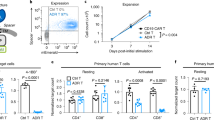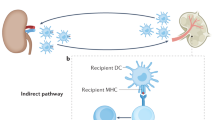Abstract
After transplantation of primarily vascularized xenografts (Xgs), T-independent mechanisms may lead to Xg rejection before T-cell activation even takes place. The possibility of achieving T-independent xenotolerance was evaluated in nude rats that normally reject hamster cardiac Xgs within 4 days by non-T cell-mediated mechanisms. After donor antigen infusion, temporary NK-cell depletion and a 4-week administration of Leflunomide, hamster heart grafts survived even after withdrawal of immunosuppression. Tolerant rats accepted second hamster hearts, but promptly rejected mouse heart Xgs. In vivo immunization and in vitro cy-totoxicity assays indicated that this species-specific tolerance was based on B-lymphocyte and NK-cell tolerance respectively.
This is a preview of subscription content, access via your institution
Access options
Subscribe to this journal
Receive 12 print issues and online access
$209.00 per year
only $17.42 per issue
Buy this article
- Purchase on Springer Link
- Instant access to full article PDF
Prices may be subject to local taxes which are calculated during checkout
Similar content being viewed by others
References
Perper, R.J. & Najarian, J.S. Experimental renal heterotransplantation. I. In widely divergent species. Transplantation 4, 377–388 (1966).
Giles, G.R. et al. Mechanism and modification of rejection of heterografts between divergent species. Transplant Proc. 2, 522–538 (1970).
Kakita, A., Blanchard, J. & Fortner, J.G. Hamster-to-rat cardiac xenografts: A useful model for transplantation studies. J. Surg. Res. 19, 99–106 (1975).
Homan, W.P., Williams, K.A., Fabre, J.W., Millad, P.R. & Morris, P.J. Prolongation of cardiac xenograft survival in rats receiving cyclosporine A. Transplantation 31, 164–166 (1981).
Platt, J.L. et al. The role of natural antibodies in the activation of xenogeneic endothelial cells. Transplantation 52, 1037–1043 (1991).
Bach, F.H. et al. Endothelial cell activation and thromboregulation during xenograft rejection. Immunol. Rev. 141, 5–30 (1994).
Leventhal, J.R. et al. Prolongation of cardiac xenograft survival by depletion of complement. Transplantation 55, 857–865 (1993).
Hancock, W.W., Blakely, M.L., van der Werf, W.J. & Bach, F.H. Rejection of guinea pig cardiac xenografts post-cobra venom factor therapy is associated with infiltration by mononuclear cells secreting IFN-y and diffuse endothelial activation. Transplant. Proc. 25, 2932 (1993).
Auchincloss, H., Jr. Xenogeneic transplantation. Transplantation 46, 1–20 (1988).
Sachs, D.H. & Bach, F.H. Immunology of xenograft rejection. Hum. Immunol. 28, 245–251 (1990).
Sykes, M., Lee, L.A. & Sachs, DH. Xenograft tolerance. Immunol. Rev. 141, 245–276 (1994).
Faustman, D. & Coe, C. Prevention of xenograft rejection by masking donor HLA class I antigens. Science 252, 1700–1702 (1991).
Pierson, R.N., Winn, H.J., Russel, P.S. & Auchincloss, H., Jr. Xenogeneic skin graft rejection is especially dependent on CD4+ T cells. J. Exp. Med. 170, 991–996 (1989).
Platt, J.L. et al. Transplantation of discordant xenografts: A review of progress. Immunol. Today 11, 450–456 (1990).
Bach, F.H. et al. Accommodation of vascularized xenografts: Expression of ‘protective genes’ by donor endothelial cells in a host Th2 cytokine environment. Nature Med. 3, 196–204 (1997).
Zhao, Y., et al. Skin graft tolerance across a discordant xenogeneic barrier. Nature Med. 2, 1211–1216 (1996).
Goodman, D.J., von Albertini, M., Willson, A., Millan, M.T. & Bach, F.H. Direct activation of porcine endothelial cells by human killer cells. Transplantation 61, 763–771 (1996).
Candinas, D. et al. T-cell independence of macrophage and NK cell infiltration, cytokine production, and endothelial activation during delayed xenograft rejection. Transplantation 62, 1920–1927 (1996).
Lin, Y., Vandeputte, M. & Waer, M. NK cell- and macrophage-mediated rejection of concordant xenografts in the absence of T- and B-cell responses. J. Immunol. 158, 5658–5667 (1997).
Roder, J.C. & Ahrlund-Richer, L. Target-effector interaction in the human and murine natural killer system: Specific and xenogeneic reactivity of the solubilized natural killer-target structure complex and its loss in a somatic cell hybrid. J. Exp. Med. 150, 471–481 (1979).
Roozemond, R.C., Das, P.K. & Halperin, M. Effect of mycobacterial lipids on membrane fluidity and natural killer cell-mediated cytotoxicity. Ann. Immunol. (Paris) 1350, 247–255 (1984).
Zinkemagel, R.M.T. T and B cell tolerance and responses to viral antigens in trans-genic mice: Implications for the pathogenesis of autoimmune versus im-munopathological disease. Immunol. Rev. 122, 133–171 (1991).
Sundstrom, J.B. & Cherniak, R. T-cell-dependent and T-cell-independent mechanism of tolerance to glucuronoxylomannan of Cryptococcus neoformans serotype A. Infect Immun. 61, 1340–1345 (1993).
Goodnow, C.C. Transgeneic mice and analysis of B cell tolerance. Annu. Rev. Immunol. 10, 489–518 (1992).
Sharabi, Y., Aksentijevich, I., Sundt, T.M., III, Sachs, D.H. & Sykes, M. Specific induction of across a xenogeneic barrier: Production of mixed rat/mouse lymphohe-matopoietic chimeras using a nonlethal preparative regimen. J. Exp. Med. 172, 195–202 (1990).
Chan, E.Y. & MacLennan, I.C. Only a small proportion of splenic B cells in adults are short-lived virgin cells. Eur. J. Immunol. 23, 357–363 (1993).
Collins, B.H., Parker, W.R. & Platt, J.L. Characterization of porcine endothelial cell determinants recognized by human natural antibodies. Xenotransplantation 1, 36 (1994).
Platt, J.L., Lindman, B.J., Chen, H., Spitalnik, S.L. & Bach, F.H. Endothelial cell antigens recognized by xenoreactive human natural antibodies. Transplantation 50, 817–822 (1990).
Cramer, D.V., Wu, C.D., Chapman, F.A. & Makowka, L. Humoral responses to xenografts: Do concordant and discordant reactions share common immune responses? Transplant. Proc. 29, 945 (1997).
Gustavsson, ML et al. Anti-carbohydrate antibodies associated with hyperacute rejection in a vascularized mouse heart-to-rat xenotransplantation model. Transplantation 61, 957–963 (1996).
Schaapherder, A.F., Daha, M.R., Bulte, M.T., Van der Woude, F.J. & Gooszen, H.G. Antibody-dependent cell-mediated cytotoxicity against porcine endothelium induced by a majority of human sera. Transplantation 57, 1376–1382 (1994).
Bach, H.F. et al. Barriers to xenotransplantation. Nature Med. 1, 869–873 (1995).
Roder, J.C. & Pross, H.F. The biology of human natural killer cell. J. Gin. Immunol. 2, 249–263 (1982).
Kiyohara, T., Dennis, J.W. & Roder, J.C. Double restriction in NK cell recognition is linked to transmethylation and can be triggered by asparagine-linked oligosaccha-rides on tumor cells. Cell. Immunol. 106, 223–233 (1987).
Rooney, C.M. & Munro, A.J. NK cells can recognize asialylated autologous lymphocytes and ABO-mismatched lymphocytes. Immunology 51, 193–199 (1984).
Ljunggren, H.G. & Karre, K. In search of the ‘missing self’: MHC molecules and NK cell recognition. Immunol. Today 11, 237–244 (1991).
Galili, U. Interaction of the natural anti-Gal antibody with α-galactosyl epitopes: A major obstacle for xenotransplantation in humans. Immunol. Today 14, 480–482 (1993).
Moller, J.R. et al. Natural killer cell recognition of target cells expressing different antigens of vesicular stomatitis virus. Proc. Natl. Acad. Sci. USA 82, 2456–2459 (1985).
Malnati, M.S. et al. Recognition of virus-infected cells by natural killer cell clones is controlled by polymorphic target cell elements. J. Exp. Med. 178, 961–969 (1993).
Wu, M.F. & Raulet, D.H. Class-I-deficient hemopoietic cells and non hemopoietic cells dominantly induce unresponsiveness of natural killer cells to class-I deficient bone marrow cell grafts. J. Immunol. 158, 1628–1633 (1997).
Umesue, M. et al. Donor-specific prolongation of rat skin graft survival induced by rat-donor cells and cyclophosphamide under co-administration of monoclonal antibodies against T cell receptor alpha beta and natural killer cells in mice. Transplantation 61, 116–124 (1996).
Sykes, M. et al. Hematopoietic cells and radioresistant host elements influence natural killer cell differentiation. J. Exp. Med. 178, 223–229 (1993).
Silva, H.T., Jr. & Morris, R.E. Leflunomide and malononitriloamide. Med. Sci. 313, 289–301 (1997).
Reynolds, C.W., Timonen, T. & Herberman, R.B. Natural killer cell activity in the rat. I. Isolation and characterization of the effector cells. J. Immunol. 127, 282–287 (1981).
Salam, A. & Waer, M. Graft-versus-host reactivity and graft-versus-leukemia effect in murine allogeneic bone marrow chimeras conditioned with total body irradiation or total lymphoid irradiation. Transplantation 61, 826–830 (1996).
Kabat, E.A. & Mayer, M.M. Measurement of total haemolytic complement activity, in Experimental Immunochemistry, 2nd edn., p. 149 (Charles C Thomas, Springfield, IL, 1961).
Coligan, J.E., Kruisbeek, A.M., Marguilies, D.H., Shevach, E.M. & Strober, W. Double antibody-sandwich ELISA to detect specific antibodies, in Current Protocols in Immunology, (eds. Coligan, J.E. et al.) 2.1, p. 11 (Wiley & Sons, New York, 1994).
Baker, P.J. Depletion of C6 prevents development of proteinuria in experimental membranous nephropathy in rats. Am. J. Pathol. 135, 185–194 (1989).
Author information
Authors and Affiliations
Rights and permissions
About this article
Cite this article
Lin, Y., Goebels, J., Xia, G. et al. Induction of specific transplantation tolerance across xenogeneic barriers in the T-independent immune compartment . Nat Med 4, 173–180 (1998). https://doi.org/10.1038/nm0298-173
Received:
Accepted:
Issue Date:
DOI: https://doi.org/10.1038/nm0298-173
This article is cited by
-
Human islet cell implants in a nude rat model of diabetes survive better in omentum than in liver with a positive influence of beta cell number and purity
Diabetologia (2010)
-
Xenotransplantation: current status and a perspective on the future
Nature Reviews Immunology (2007)
-
Expression of heme oxygenase-1 can determine cardiac xenograft survival
Nature Medicine (1998)



